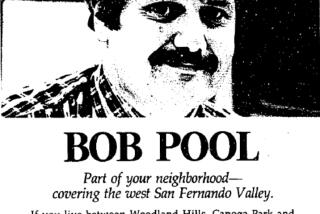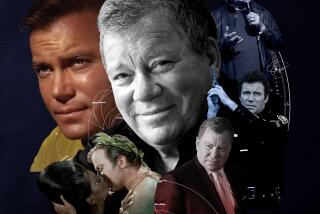Baja Author Is Reloading the Cannon
- Share via
Gene Kira had to see it for himself, and sure enough, there it was, in the dank confines of the collection room in UCLA’s ichthyology department, stuffed headfirst in a jar full of alcohol, all mottled and brown-- Opisthognathus rhomalea.
The Bigmouth Bastard, in the flesh, 40-plus years removed from its watery world south of the border and looking very much its age.
Former UCLA biologist Boyd Walker, after all, is the one who bestowed the ignoble title upon this little fish with a disproportionately large mouth, a voracious bottom-dweller, and legendary Baja California author Ray Cannon is the one who made it stick, having written about it often in the 1950s and ‘60s.
The two fished together several times on collection expeditions in the Sea of Cortez, which resulted in the eventual identification of dozens of new species.
And as the story goes, after one such trip in the mid-1950s, Walker told Cannon that the first rhomalea brought to the university had been misplaced by one of his students. When he asked his class where “that strange-looking fish” went, another student asked Walker which strange-looking fish he was talking about, whereon the professor replied, “You know, that big-mouthed bastard.”
Cannon, in his popular and comprehensive hard-cover “The Sea of Cortez” (Lane Magazine and Book Company, 1966), later explained that it was he who convinced Walker that there was no reason to call this fish by any other name.
“Walker agreed with my suggestion that, whenever reasonable, a thing should be known by the first name ever applied to it,” Cannon wrote. “This seemed a most reasonable situation, so the common name ‘bigmouth bastard’ stuck.”
Kira, who insists he is not the second coming of Ray Cannon (although he is growing a beard to look the part of a Baja vagabond, much as Cannon did), is writing a book about the modern history of Baja California centering primarily on the life of Cannon, the man largely credited with putting the desert peninsula on the map from a tourism standpoint.
Kira, 52, a Japanese American who lives near San Diego, has spent the past year or so traveling throughout Baja, talking to anyone who might have encountered Cannon before he died in 1977-and investigating some of the more bizarre stories Cannon shared with his readers over the years.
I was invited along for the trip to UCLA to see if this bigmouth you-know-what really did exist, because Cannon, despite his familiarity with Baja and his expertise with a rod and reel, was known to embellish on occasion.
We found, however, that not only are there a couple of these rhomalea creatures in the collection room--they’re about a foot long with elongated dorsal fins like those of a wrasse and a large head similar to that of a bass--but there are numerous other specimens taken from the same location off the Sonora coast in the northern Sea of Cortez.
That location is Bigmouth Bastard Point. Or so it says in the record books in the life sciences building at UCLA.
Fans of Baja, and especially fans of the late Ray Cannon, are probably in for a treat when Kira’s book, “The Unforgettable Sea of Cortez,” is published early next year.
Kira shares the same passion Cannon had for Baja and its people, and like Cannon, Kira is adept at keeping his readers entertained.
He proved that soulfully and convincingly with his most recent effort, a self-published novel called “King of the Moon” (Apples and Oranges, $21.95), a marvelous character-driven portrayal of life in a small, impoverished fishing village in southern Baja. The book, also available through https://www.amazon.com, received solid reviews and recently was voted best mainstream novel by the San Diego Book Awards Assn.
Kira and Mike Bales of Cortez Publications in Torrance are excited about this new endeavor because not only do they have in Cannon a colorful old salt who got the tumbleweed rolling as far as sportfishing in Baja is concerned, but they have access to piles of unpublished Ray Cannon memorabilia, which they discovered at the Los Angeles home of Carla Laemmle, a former dancer and actress and Cannon’s live-in companion for more than 40 years.
With this at their disposal they soon discovered that there was a lot more to this chronicler of Baja and its waters than his readers ever realized.
Ray Cannon’s real name, for instance, was Ulysses Tillman Cannon, and he was known merely as Cousin Tillman to his relatives in the hills of Tennessee, where he grew up.
Ray was merely his stage name. He got his start in show business after being asked to fill in as an extra while fishing on a beach in Santa Monica. He went on to become a silent-movie star and one of Hollywood’s top screenwriters.
He worked with Charlie Chaplin, Theda Bara, Buster Keaton and Dorothy Gish, to name a few. In 1928 he directed the highly acclaimed movie, “Red Wine,” starring Conrad Nagel.
In 1942, he volunteered to join the U.S. Army Motion Picture unit. He was turned down by then second-lieutenant Ronald Reagan, who wrote back telling Cannon that those positions “have all been frozen.”
Cannon finally burned out on the Hollywood scene and retired in 1945. An avid fisherman, he traveled to Baja for the first time in 1948 and found the waters off San Felipe teeming with totuava, a member of the croaker family similar to the white seabass.
He was hooked on the wildness of the land and the friendliness of its people.
Having already written a fishing book dealing with the Pacific coast north of the border, he took his pen south, and the farther he went, the wilder the land became and the bigger and more varied the marine life was.
Cannon became a regular contributor to Western Outdoor News, which was launched in 1953. He wrote frequently for outdoor magazines such as Field & Stream. He introduced other writers to a world they found equally amazing.
Hotels began to spring up, built by entrepreneurs who saw the interest in sportfishing in Baja rising like tuna after sardines. Cannon made friends with all the important people--Luis Coppola Bonillas, Bud Parr and Luis Bulnes, to name a few--and promised to bring them customers in return for free lodging and fishing, which unfortunately remains a common practice of many an outdoor writer today.
Cannon preferred to write mostly positive stories because his philosophy, according to Kira, was to make people happy. “He saw Baja as an unlimited wilderness never to be spoiled, and his role, he believed, was to inform people of this happy refuge far removed from the insane crush of the industrial world north of the border,” Kira said.
Kira soon learned, though, that Cannon was never able to completely shake Hollywood. Like any actor, he knew he needed an image so he grew a scruffy gray beard and put on a mariner’s cap that made him look like something out of Hemingway’s “Old Man and the Sea.” With these he was in character.
Like any director, he knew things had to be perfect before they were shown to the public, so he often set up photographs when the real thing didn’t cut it, not giving a thought to the fact that this went against the very fabric of ethical journalism.
For example, on Page 210 of “The Sea of Cortez” is a brilliant color picture of a needlefish supposedly leaping out of the water in full fight, with the alleged fisherman in a panga holding a rod fighting the fish in the background.
Kira said he discovered other photos showing another fisherman closer to but out of view of the camera, lifting the already-subdued needlefish out of the water with his rod to make it look as if it were jumping.
Bob Van Wormer, owner of three popular East Cape hotels, said Cannon once had him go overboard and repeatedly toss a dead dorado into the air near the boat so Cannon could get the perfect aerial shot.
“By no means was he a phony,” Kira was quick to point out, stressing that actions such as these were merely the result of the instincts Cannon acquired in his years as an actor and director. “Ray knew the score and he was highly qualified to write about Baja, but most of all, he knew what people wanted.”
More to Read
Sign up for our Book Club newsletter
Get the latest news, events and more from the Los Angeles Times Book Club, and help us get L.A. reading and talking.
You may occasionally receive promotional content from the Los Angeles Times.










